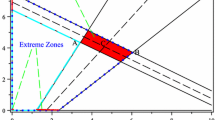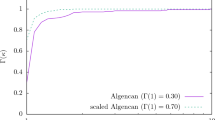Abstract
In this paper, we present an original method to solve convex bilevel programming problems in an optimistic approach. Both upper and lower level objective functions are convex and the feasible region is a polyhedron. The enumeration sequential linear programming algorithm uses primal and dual monotonicity properties of the primal and dual lower level objective functions and constraints within an enumeration frame work. New optimality conditions are given, expressed in terms of tightness of the constraints of lower level problem. These optimality conditions are used at each step of our algorithm to compute an improving rational solution within some indexes of lower level primal-dual variables and monotonicity networks as well. Some preliminary computational results are reported.
Similar content being viewed by others
References
Abdou-Kandil H., Bertrand P.: Government-private sector relations as a stackelberg game: a degenerate case. J. Econ. Dyn. Control 11, 513–517 (1987). doi:10.1016/S0165-1889(87)80004-0
Audet C., Hansen P., Jaumard B., Savard G.: Links between linear bilevel and mixed 0–1 programming problems. J. Optim. Theory Appl. 93(2), 273–300 (1997). doi:10.1023/A:1022645805569
Bard J.F., Moore J.T.: A branch and bound algorithm for the bilevel programming problem. SIAM J. Sci. Stat. Comput. 11, 281–292 (1990). doi:10.1137/0911017
Bard J.F.: Convex two-level programming. Math. Program. 40(1), 15–28 (1988). doi:10.1007/BF01580720
Bard J.F.: Optimality conditions for the bilevel programming problem. Nav. Res. Logist. Q. 31, 13–26 (1984). doi:10.1002/nav.3800310104
Bard J.F., Plummer J.C., Sourie J.C.: A bilevel programming approach to determining tax credits for biofuel production. Eur. J. Oper. Res. 120, 30–43 (2000). doi:10.1016/S0377-2217(98)00373-7
Ben-Ayed O., Blair C.: Computational difficulties of bilevel linear programming. Oper. Res. 38, 556–560 (1990). doi:10.1287/opre.38.3.556
Bertier, P., Roy, B.: Procédures de résolution pour une classe de problème pouvant avoir un caractère combinatoire. Cahier du centre d’études de recherche opérationnelle, 6 (1964)
Bialas W.F., Karwan M.H.: Two-level linear programming. Manage. Sci. 30(8), 1004–1020 (1984). doi:10.1287/mnsc.30.8.1004
Brotcorne L., Labbé M., Marcotte P., Savard G.: A bilevel model and solution algorithm for a freight tariff setting problem. Transp. Sci. 34, 289–302 (2000). doi:10.1287/trsc.34.3.289.12299
Calvete H.I., Gale C.: On the quasiconcave bilevel programming problem. J. Optim. Theory Appl. 98(3), 613–622 (1998). doi:10.1023/A:1022624029539
Campêlo M., Dantas S., Scheimberg S.: A note on a penalty function approach for solving bilevel linear programs. J. Glob. Optim. 16, 245–255 (2000). doi:10.1023/A:1008308218364
Candler, W., Norton, R.: Multi-level programming and development policy. World bank development research center discussion paper, vol. 258, Washington, May (1977b)
Candler, W., Norton, R.: Multi-level programming. World bank development research center discussion paper, vol. 20, Washington, January (1977a)
Candler W., Townsley R.: A linear two-level programming problem. Comput. Oper. Res. 9, 57–76 (1982). doi:10.1016/0305-0548(82)90006-5
Chen Y., Florian M.: The nonlinear bilevel programming problem: formulation, regularity and optimality conditions. Optimization 32, 193–309 (1995). doi:10.1080/02331939508844048
Clarke L.E.: On cayley’s formula for counting trees. Proc. Camb. Philos. Soc. 59, 509–517 (1963). doi:10.1017/S0305004100037178
Colson B., Marcotte P., Savard G.: Bilevel programming: a survey. 4OR Q. J. Oper. Res. 4(R 3), 87–107 (2005)
Dempe S.: A simple algorithm for the linear bilevel programming problem. Optimization 18, 373–385 (1987). doi:10.1080/02331938708843247
Dempe S.: A necessary and sufficient optimality for bilevel programming problem. Optimization 2, 341–354 (1992). doi:10.1080/02331939208843831
Dempe S.: Annoted bibliography on bilevel programming and mathematical programs with equilibrium constraints. Optimization 52, 333–359 (2003). doi:10.1080/0233193031000149894
Etoa, E.J.B.: Contribution à la résolution des programmes mathématiques à deux niveaux et des programmes mathématiques avec contraintes d’équilibre, PhD Thesis, École Polytechnique de Montréal, December (2005)
Facchinei F., Fischer A., Kanzow C.: On the accurate identification of active constraints. SIAM J. Optim. 9, 14–32 (1998). doi:10.1137/S1052623496305882
Falk J.E., Liu J.: On bilevel programming, part I: general nonlinear case. Math. Program. 70, 47–72 (1995)
Gümüs Z.H., Floudas C.H.: Global optimization of nonlinear bilevel programming problems. J. Glob. Optim. 20, 1–31 (2001). doi:10.1023/A:1011268113791
Hansen P., Jaumard B., Lu S.H.: A frame work for algorithms in globally optimal design. ASME J. Mech. Autom. Transm. 111, 353–360 (1989)
Hansen P., Jaumard B., Savard G.: New branch-and-bound rules for linear bilevel programming. SIAM J. Sci. Stat. Comput. 13, 1194–1217 (1992). doi:10.1137/0913069
Jeroslow R.G.: The polynomial hierarchy and simple model for competitive analysis. Math. Program. 32, 146–164 (1985). doi:10.1007/BF01586088
Kolstad C.D., Lasdon L.: Derivative evaluation and computational experience with large bilevel mathematical programs. J. Optim. Theory Appl. 65, 485–499 (1990). doi:10.1007/BF00939562
Kornaj J., Liptak T.: Two-level planning. Econometrica 33, 141–169 (1965). doi:10.2307/1911892
Labbé M., Marcotte P., Savard G.: A bilevel model of taxation and its application to optimal highway pricing. Manage. Sci. 44, 1608–1622 (1998). doi:10.1287/mnsc.44.12.1608
Lin, G.H., Fukushima, M.: Hybrid algorithms with active set identification for mathematical programs with complementarity constraints, Technical Report 2002–2008, Department of Applied Mathematics and Physics, Graduate School of Informatics, Kyoto University, Kyoto, Japan (2003)
Little, J.D.C., Murty, K.G., Sweeney, D.W., Karel, C.: An algorithm for the traveling salesman problem. J. OSRA, 11 (1963)
Marcotte, P., Savard, G.: Bilevel programming: a combinatorial perspective, graph theory and combinatorial Optimization. In: Avis, D., Hertz, A., Marcotte, O. (eds.) Springer, Berlin (2005)
Muu L.D., Quy N.V.: A global optimization method for solving convex quadratic bilevel programming problems. J. Glob. Optim. 26, 199–219 (2003). doi:10.1023/A:1023047900333
Rockafellar R.T.: Convex analysis. Princeton University Press, Princeton (1970)
Ross S.A.: The economic theory of agency: the principal’s problem. AER 63, 134–139 (1973)
Savard G., Gauvin J.: The steepest descent direction for the nonlinear bilevel programming problem. Oper. Res. Lett. 1, 265–272 (1994). doi:10.1016/0167-6377(94)90086-8
Savard, G.: Contribution à la programmation mathématique à deux niveaux, PhD Thesis, École Polytechnique de Montréal (1989)
Still G.: Linear bilevel problems: genericity results and efficient method for computing local minima. Math. Methods Oper. Res. 5, 383–400 (2002). doi:10.1007/s001860200189
Vicente L.N., Calamai P.H.: Bilevel and multilevel programming, a bibliography review. J. Glob. Optim. 5(3), 291–306 (1994). doi:10.1007/BF01096458
Vicente L.N., Savard G., Jùdice J.: Descent approach for quadratic bilevel programming. J. Optim. Theory Appl. 81, 379–399 (1994). doi:10.1007/BF02191670
Wang S., Lootsma F.A.: A hierarchical optimization model of resource allocation. Optimization 28, 351–365 (1994). doi:10.1080/02331939408843928
Wang, G.M., Wan, Z.P., Wang, X.J.: Genetic algorithm for solving convex quadratic bilevel programming problems, working paper. AMS, MOS subject classifications: 90C30 (2003)
Wilde D.: Monotonicity and dominance in optimal hydraulic cylinder design. J. Eng. Ind. 97(4), 13–26 (1975)
Author information
Authors and Affiliations
Corresponding author
Additional information
The algorithm presented in this paper was conceived during a PhD research program of the author at MAGI, École Polytechnique de Montréal, C. P. 6079, succ. Centre-ville Montréal (Québec), H3C 3A7 Canada [21].
Rights and permissions
About this article
Cite this article
Etoa, J.B.E. Solving convex quadratic bilevel programming problems using an enumeration sequential quadratic programming algorithm. J Glob Optim 47, 615–637 (2010). https://doi.org/10.1007/s10898-009-9482-3
Received:
Accepted:
Published:
Issue Date:
DOI: https://doi.org/10.1007/s10898-009-9482-3




